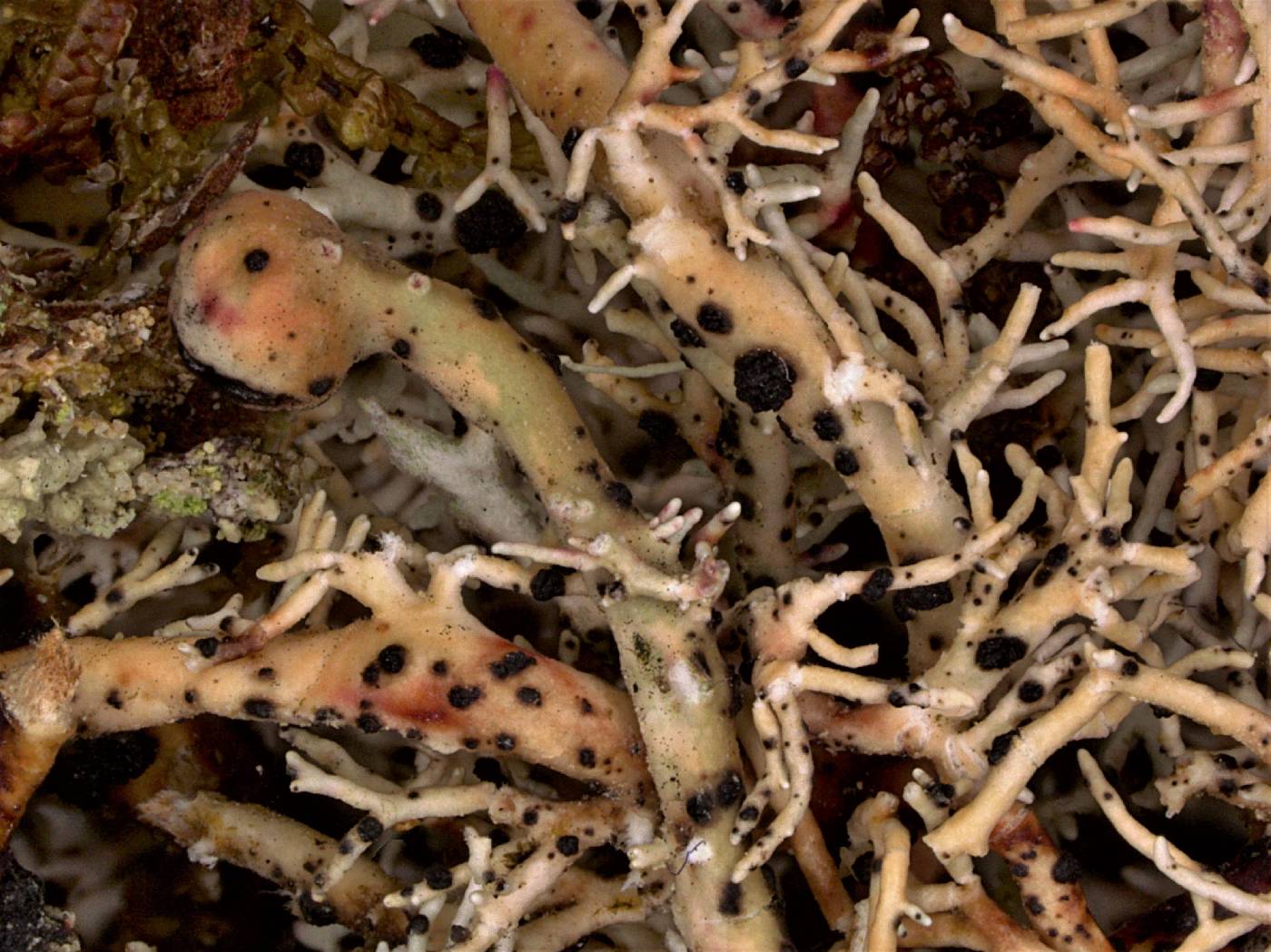
Consortium of Lichen Herbaria
- building a Global Consortium of Bryophytes and Lichens as keystones of cryptobiotic communities -
- Home
- Search
- Images
- Species Checklists
- US States: O-Z >
- US National Parks
- Central America
- South America
- US National Parks
- Southern Subpolar Region
|
Family: Opegraphaceae |
Nash, T.H., Ryan, B.D., Gries, C., Bungartz, F., (eds.) 2007. Lichen Flora of the Greater Sonoran Desert Region. Vol 3. Life habit: lichenized, or non-lichenized and lichenicolous Thallus: crustose, thin to thick, smooth or ±rimose, sometimes partially or entirely immersed, prothallus often present and mosaic forming; in section without a differentiated cortex surface: white, gray, mauve-gray, gray-brown, dark brown, yellowish or olive-green; soralia: occasionally present photobiont: Trentepohlia or Phycopeltis Ascomata: lirellate, ±elongate, rarely ±rounded, sometimes branched or stellate, discrete or confluent, rarely densely clustered and contiguous, ±sessile, rarely immersed disc: ±exposed or remaining slit-like, occasionally yellow-green, orange or white-pruinose exciple: usually prominent from the beginning, dark brown to black, composed of a plectenchyma of conglutinated hyphae with the individual hyphae not easily discerned, closed or rarely open under the hypothecium or the subhymenium, K- or K+ olivaceous or green hymenium: hyaline, rarely pale brown to dark purplish brown; hymenial gel I+ reddish brown or + blue, K/I+ blue or blue-green; epihymenium colorless in species with a slit-like disc, or brown to black, occasionally olivaceous or greenish where exposed; paraphysoids branched, often richly anastomosing, septate, apices not or rarely slightly swollen; hypothecium: hyaline, pale to dark brown, or olivaceous, K- or + olive-green asci: bitunicate with fissitunicate dehiscence, (2-6-)8-spored, clavate to cylindrical-clavate or clavate-subglobose; ascal wall: continuously thickened towards the apex, with the inner layer K/I+ blue, and often with a minute, apical K/I+ blue ring around the apex of the ocular chamber ascospores: 9-85 x 2-9 µm, ±oblong, fusiform or acicular, 1-15-septate, hyaline or very rarely with a brownish wall, smooth, I-; often surrounded by a gelatinous perispore, hyaline or becoming brownish and sometimes granulose when over-mature ta: pycnidial, immersed to sessile, punctiform, black, rarely pruinose; conidiogenous cells mainly oblong-ampulliform, arising singly, enteroblastic, acrogenous conidia: variable, simple, rarely septate, colorless, ellipsoid to bacilliform or sickle-shaped Secondary metabolites: no substances, or in a few species with erythrin, gyrophoric or lecanoric acids, or unidentified pigments Substrate: on a wide range of substrates, including bark or leaves of young and mature broad-leaved trees or shrubs, more rarely conifers and wood; also on often sheltered, acid, neutral or basic rocks, rarely on soil and dead herbs; many species are lichenicolous Geography: cosmopolitan. Notes: The genus is superficially similar to Graphis, which differs mainly in having simple paraphyses, I+ purple ascospores with lenticular cells, and quite different nonfissitunicate asci. The relationship of Opegrapha to other genera in the Roccellaceae is still being clarified. The size and shape of the conidia are an important diagnostic feature of many species. The number of ascospores septa is frequently diagnostic; sometimes one of the middle cells is ± enlarged. The first modern monographic treatment of Opegrapha was made by Redinger (1937-1938) for European species. Western Mediterranean species were mono-graphed by Torrente and Egea (1989). In North America, the genus is represented by over 30 species (Esslinger and Egan, 1995). This is a large and difficult genus, especially for the corticolous and lignicolous species with a lot of contradictions in the literature, and some unsolved problems. Following Torrente and Egea (1989), three types of asci are recognized: 1) Calcarea-type: clavate-subglobose, inner layer of endoascus only K/I+ blue in upper part, apical K/I+ blue ring inconspicuous, ocular chamber large and with an apical nasse (O. atra); 2) Varia-type: clavate, inner layer of endoascus only K/I+ blue in upper part, apical K/I+ blue ring more or less conspicuous, ocular chamber short, without apical nasse (O. anomea, O. brevissima, O. corinnae, O. glaucomaria, O. herbarum, O. pulvinata, O. ochrocheila and O. varia); 3) Vulgata-type: cylindric-clavate, inner layer of endoascus K/I+ blue at least in the middle upper part, apical K/I+ blue ring more or less conspicuous, ocular chamber short, without apical nasse (O. brattiae, O. erosa, O. niveoatra, O. umbellulariae and O. vulgata). Following the same authors, together with new observations, several types of ascospores are recognized in the Sonoran Desert: 1) Calcarea-type: ellipsoid to clavate, often up to 20 µm long, 3-5-septate, cell walls not or slightly swollen at septa, surrounded or not by a thin gelatinous sheath, rarely becoming covered by brownish granular warts when old (O. atra, O. brattiae, O. erosa, O. ochrocheila, O. umbellulariae and O. xerica); 2) Subelevata-type: elongate-clavate to fusiform, with ends rounded, usually more than 20 µm long, 3(-4)-septate, cell walls swollen or not at septa, surrounded by a distinct gelatinous sheath, often becoming covered by brownish granular warts when old (O. herbarum); 3) Varia-type: elongate-clavate to fusiform, with ends rounded, usually more than 20 µm long, 5-7(-8)-septate, cell walls somewhat swollen at septa, usually with enlarged middle cell, surrounded by a distinct gelatinous sheath, often becoming covered by brownish granular warts when old (O. varia); 4) Vulgata-type: elongate-fusiform to acicular, tapered at least at one end, usually more than 20 µm long, (4-)5-15-septate, cell walls somewhat swollen at septa, with cells more or less the same size, usually surrounded by a distinct gelatinous sheath, often becoming evenly brown when old (O. niveoatra and O. vulgata); 5) Parasitica-type: this new type is characterized by ascospores which are clavate to elongate-fusiform, with rounded ends, variable in length, 3-7-septate, cell wall swollen at the septa, with more or less roundish cells, surrounded by a gelatinous sheath, becoming brown and often granular when mature (O. anomea, O. brevissima, O. corinnae, O. glaucomaria, O. longissima, O. physciaria and O. pulvinata). |
Powered by Symbiota









